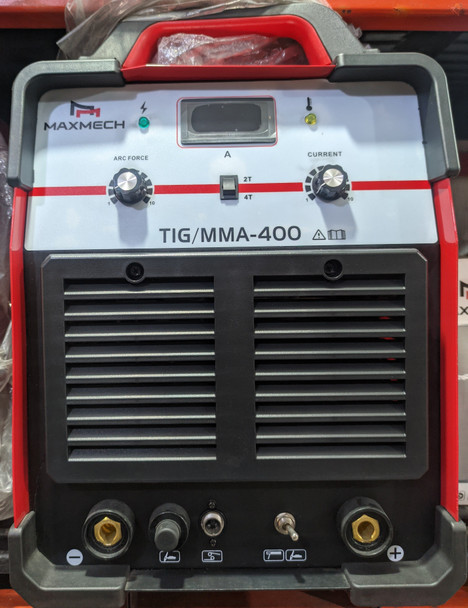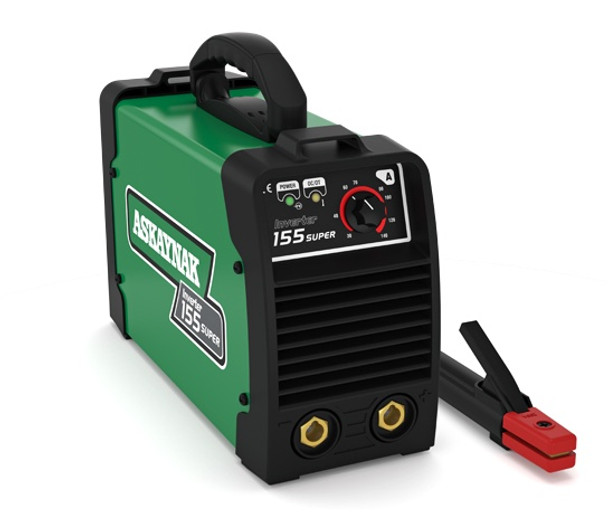Difference Between AC and DC Welding machines
Difference between AC and DC Welding Machines
What Is Welding?
Welding is a process used to join metals together by melting the parts and using a filler to form a joint. Welds can be accomplished using different energy sources from a gas flame or electric arc to a laser or ultrasound. Welding cannot be done with all types of metals. For example, stainless steel is prone to cracking and distortions when it is overheated. Alloys are often a problem because it is difficult to know the exact chemical composition of the metal.
For a welder to make the best welds he must understand what alternating current (AC) and direct current (DC) signify on the welder as well as on electrodes.
Maxmech Inverter Welding Machine TIG/MMA-400
What does Alternating and Direct currents mean?
Electricity flows in two ways: either in an alternating current (AC) or in a direct current (DC). Electricity or "current" is nothing but the movement of electrons through a conductor, like a wire. The difference between AC and DC lies in the direction in which the electrons flow. In DC, the electrons flow steadily in a single direction, or "forward." In AC, electrons keep switching directions, sometimes going "forward" and then going "backward."
Alternating current is the best way to transmit electricity over large distances.
AC and DC are terms that refer to the polarity of the electrical current that is created by the welder and runs through the electrode.
The strength of a weld depends on selecting an electrode with the correct polarity because the polarity of the electrode can significantly affect both the strength of the weld as well as the quality of the weld
What Is Polarity?
Every electrical circuit has a negative and positive pole. Direct current flows in a single direction resulting in a constant polarity. Alternating current or AC current flows in one direction half of the time and in the opposite direction the other half. AC current changes its polarity 120 times per second with a 60 hertz current.
With few exceptions, electrode-positive (reversed polarity) results in deeper penetration. Electrode-negative (straight polarity) results in faster melt-off of the electrode and, therefore, faster deposition rate. The effect of different chemicals in the covering may change this condition. Though AC itself has no polarity, when AC electrodes are used on DC they usually operate best on one specific polarity. The covering on the electrode designates which polarity is best and all manufacturers specify on the electrode container what polarity is recommended. The use of the AC transformer-type welder necessitated the development of an electrode that would work on either polarity, due to the constant-changing of the polarity in the AC circuit.
In order for one to achieve proper penetration, uniform beading and good welding results the correct polarity must be used when welding with any given metallic electrode.
Incorrect polarity will cause poor penetration, irregular bead shape, excessive spatter, difficulty in controlling the arc, overheating, and rapid burning of the electrode.
Most machines are clearly marked as to what the terminals are, or how they can be set for either polarity. Some machines have a switch to change polarity, whereas on others it is necessary to change the cable terminals
Ingco Diesel Welder generator GDW65001
Other differences between Ac Current and Dc Current.
- In Ac, it is safe to transfer over longer city distances and can provide more power while in Dc,Voltage of DC cannot travel very far until it begins to lose energy -Amount of energy that can be carried.
- Steady magnetism along the wire while in Ac, it rotates magnet along the wire.Cause of the direction of flow of electrons
- The frequency of alternating current is 50Hz or 60Hz depending upon the country while that of Dc the frequency of direct current is zero.Frequency
- Ac reverses its direction while flowing in a circuit. Dc flows in one direction in the circuit.Direction
- Ac current of magnitude varies with time. Dc has constant magnitude- Current.
- In Ac, Electrons keep switching directions - forward and backward, while in Dc Electrons move steadily in one direction or 'forward- Flow of Electrons
- Ac has a passive parameter Impedance, while Dc its passive parameter is resistance only
- Ac Lies between 0 & 1. Dc is always 1-Power Factor
- Ac types are Sinusoidal, Trapezoidal, Triangular, Square. Dc types are pure and pulsating.
- Ac is obtained from A.C Generator and mains. Dc is obtained from Cells or battery
Its ideal for the following types of welds;
1. Downhand heavy plates
2. Fast Fill
3. Aluminium TIG welding with Hi frequency
While DC current is best used for ;
1. Hard facing.
2. Single Carbon brazing.
3. Build up of heavy deposits.
4. Stainless Steel TIG welding and;
5. Cutting tap
Askaynak ELectrical welding machine Inverter 155 Super
In DC reverse polarity, the electrode is positive and the current flows from the workpiece to the electrode. It is ideal for:
- Overhead welding
- Vertical welding
- Cast iron welding
- Heavy aluminium
- Rivet welding
- Sheet metal
- Low hydrogen welding
- Arc bronze rod
Reasons/ Advantages of Their needs
When it comes to stick welding applications DC welding offers certain advantages over AC. Normally, starts are easier, there are fewer arc outages and sticking, there is less spatter, welds have a better appearance, welding vertically or overhead is much easier and DC current is the best ways for beginners to learn “how to weld”. DC welding also provides a smoother arc and DC straight polarity welds a lot of thinner metals better than AC.
The main advantage of AC output welding is that, it enables one to weld on magnetized materials because the current alternates between polarities. DC output does not work on magnetized materials because of “arc blow” which is when the magnetic field blows molten filler metal out of the weld puddle.
Safety procedures for using these Welding machines
There are requirements for personal safety equipment and fire-prevention measures that welders must observe/ abide by.
Welding fumes can cause breathing problems in welders. Some problems are short term and others may be long term illnesses like asthma. Welding fumes are also internationally classified as possible carcinogens. And burns are probably the most common injury associated with welding. Personal protective clothing can significantly reduce the risk of burns
Esab warrior 500i Multipurpose Inverter arc welding machine
Personal protective equipment for welders includes
- Fire-resistant clothing,
- safety glasses,
- shoes,
- gloves,
- hood and welding helmet and leathers. Synthetic clothing should never be worn because it melts when exposed to extremely high heat. Wool is a better choice because it is durable and resistant to fire.
One should have it in mind that, Pants and shirts should not be rolled up because sparks can get deposited in the folds. Pants should also be worn outside of shoes or work boots to protect particles from falling inside the shoes or boots. Safety goggles should always be worn under the welding helmet. If safety glasses are used instead of goggles they should also have side shields.
AC And DC welding are both needed to accomplish certain tasks. DC welding generally has more advantages over AC welding but the most important thing for a welder to understand is how polarity works so that the welder can choose the proper electrode with the right polarity for the job. For inquiries or quotes contact us on info@gz-ind.com
Related Articles
Lead to buy a good welding machine in Nigeria










